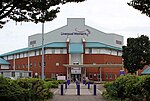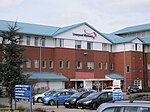Al-Rahma Mosque, Liverpool
1974 establishments in EnglandBuildings and structures in LiverpoolEuropean mosque stubsMerseyside building and structure stubsMosque buildings with domes ... and 5 more
Mosques completed in 1974Mosques in EnglandReligion in LiverpoolSunni Islam in the United KingdomUse British English from April 2015

The Al-Rahma Mosque (Arabic: مسجد الرحمة, romanized: Masjid ar-Raḥmah, lit. 'Mosque of Mercy') is a mosque located on Hatherley Street in Toxteth, Liverpool, England, which can accommodate between 2,000 and 2,500 people and serves as the main place of worship and focus point for Liverpool's Muslim population, estimated at 25,000 people.
Excerpt from the Wikipedia article Al-Rahma Mosque, Liverpool (License: CC BY-SA 3.0, Authors, Images).Al-Rahma Mosque, Liverpool
Hatherley Street, Liverpool Toxteth
Geographical coordinates (GPS) Address External links Nearby Places Show on map
Geographical coordinates (GPS)
| Latitude | Longitude |
|---|---|
| N 53.394277777778 ° | E -2.9606388888889 ° |
Address
Al-Rahma Mosque
Hatherley Street
L8 2TF Liverpool, Toxteth
England, United Kingdom
Open on Google Maps











